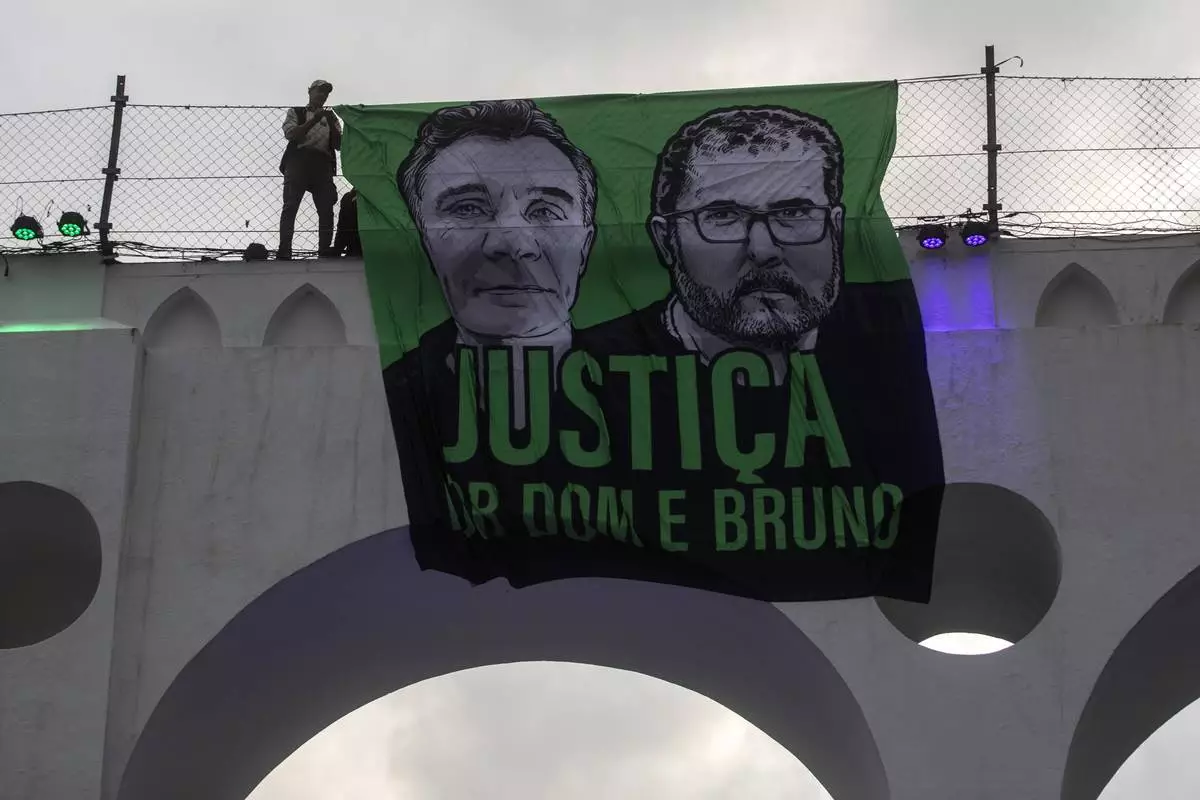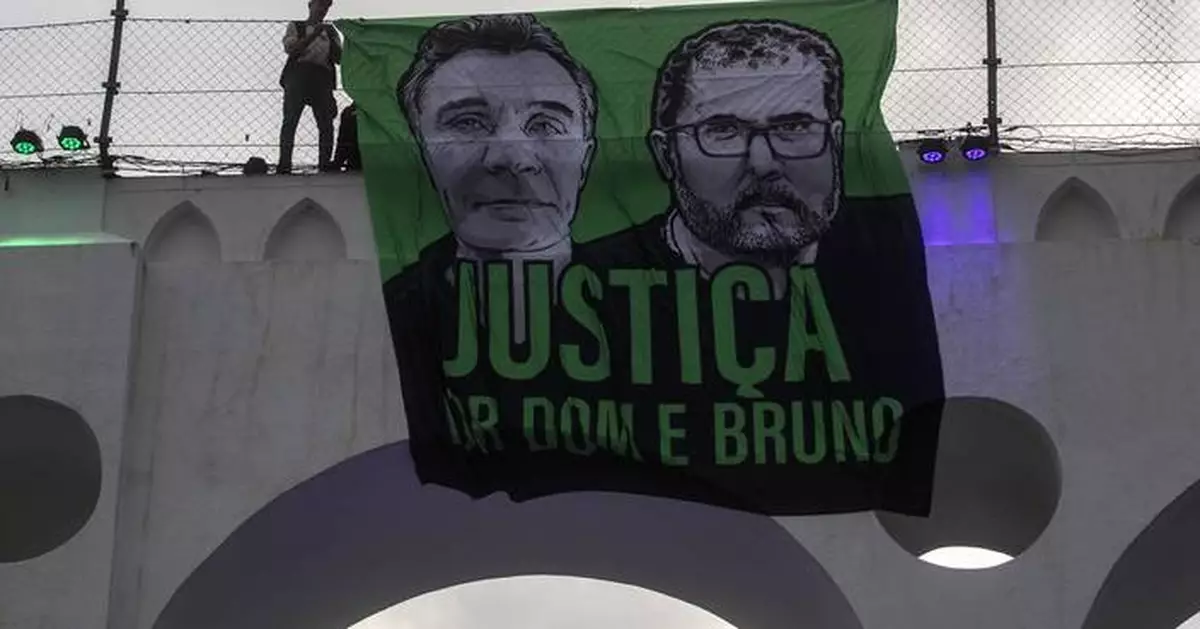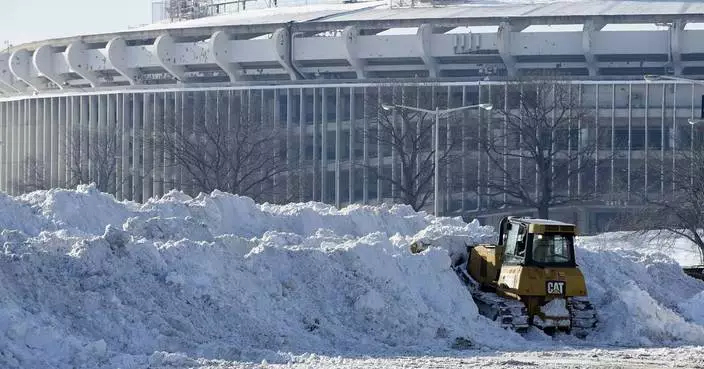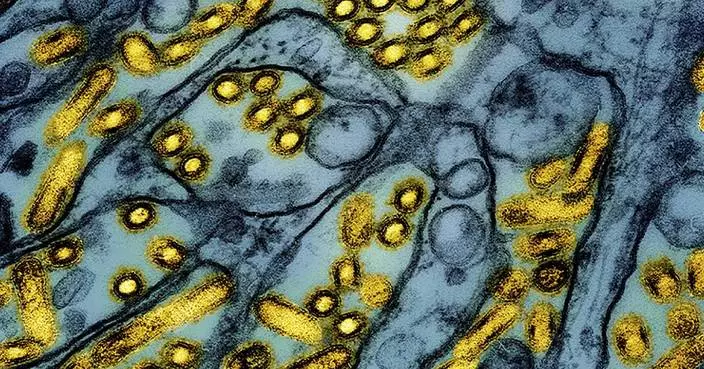BRASILIA, Brazil (AP) — A federal court in Brazil dismissed charges Tuesday against one of three men arrested for the killings of Indigenous peoples expert Bruno Pereira and British journalist Dom Phillips in the Amazon, ruling there wasn’t enough evidence to try him.
Oseney da Costa de Oliveira, a poor fisherman who lived by the Itaquai River, was arrested on June 14, 2022, nine days after the slayings.
Also arrested were his brother, Amarildo da Costa de Oliveira, and Jefferson da Silva Lima, who confessed to the killings but claimed self-defense. The Federal Regional Court of the 1st Region upheld a lower court decision that they will now face a jury trial.
With the ruling, Oseney Oliveira, a father of four, will be released following 27 months in prison, most in a federal penitentiary thousands of miles from Atalaia do Norte, his hometown in Brazil’s Amazon, where the killings occurred.
A Colombian businessman, Rubens Villar Coelho, stands accused of masterminding the slayings and is also in custody. As the owner of a floating fish warehouse outpost, he financed illegal fishermen who ventured onto Indigenous land. He denies any involvement in the killings.
In a statement, Univaja, an association of Indigenous peoples of the Javari Valley where Pereira was working at the time of his killing, said it received the ruling with “indignation” and “concern” and urged federal prosecutors to appeal the decision.
Phillips and Pereira were traveling along the Itaquai River near the entrance of the Javari Valley Indigenous Territory, which borders Peru and Colombia, when they were attacked. Their bodies were dismembered, burned and buried. Their disappearance sparked intense international outcry and pressure for action.
Pereira, a well-known advocate for Indigenous rights, fought against illegal fishing in Javari area, while Phillips, an experienced journalist, was working on a book about Amazon preservation.
The Associated Press’ climate and environmental coverage receives financial support from multiple private foundations. AP is solely responsible for all content. Find AP’s standards for working with philanthropies, a list of supporters and funded coverage areas at AP.org.

FILE - A sign that reads in Portuguese "Justice for Dom and Bruno" and with images of the British journalist Dom Phillips, on the left, and the indigenous specialist Bruno Pereira is displayed on the Arcos da Lapa aqueduct during a protest by environmental groups in Rio de Janeiro, Brazil, June 26, 2022. (AP Photo/Bruna Prado, File)
New York Giants (2-12) at Atlanta (7-7)
Sunday, 1 p.m. EST, Fox
BetMGM NFL Odds: Falcons by 8 1/2.
Against the spread: Giants 4-10; Falcons 6-8.
Series record: Falcons lead 14-12.
Last meeting: Falcons beat the Giants 17-14 on Sept. 26, 2021, in East Rutherford, N.J.
Last week: Giants lost to the Ravens 35-14; Falcons beat the Raiders 15-9.
Giants offense: overall (29), rush (18), pass (30), scoring (32)
Giants defense: overall (T21), rush (31), pass (7), scoring (20)
Falcons: overall (9), rush (12), pass (6), scoring (20)
Falcons defense: overall (20), rush (13), pass (24), scoring (20)
Turnover differential: Giants minus-8; Falcons minus-7.
WR Malik Nabers had his third double-digit catch game of the season against the Ravens and joined Odell Beckham Jr., Jaylen Waddle and Brock Bowers as the only rookies in NFL history with three games of 10-or-more receptions. The No. 6 overall pick in the draft, Nabers has 90 catches for 901 yards and is two shy of breaking the Giants rookie record of 91 held by Beckham (2014) and Saquon Barkley (2018).
QB Michael Penix Jr. will make his first career start after the Falcons benched 13-year veteran Kirk Cousins. Penix, the Heisman Trophy runner-up at Washington in 2023, was the No. 8 pick in this year's draft but wasn't expected to land the starting job so soon. The timetable ramped up dramatically when Cousins threw nine interceptions and just one touchdown over the past five games. After pulling out an ugly 15-9 win at Las Vegas, where it became clear that the Falcons had lost confidence in their passing game, the decision was made to switch to Penix.
Atlanta's defensive front vs. Giants offensive line. After managing a league-low 10 sacks through their first 11 games, the Falcons have turned up the pressure with 13 sacks in three games since their bye week. Eight players have notched sacks during that span, led by OLB Kaden Elliss and DE Arnold Ebiketie with three apiece. With Drew Lock set to return as New York's quarterback after missing last week with a heel injury, the Falcons will be looking to bring the heat against a team that has allowed 45 sacks, tied for seventh most in the NFL.
Giants: QB Tommy DeVito, who started last week in place of Lock, is out of concussion protocol and should be the backup. … G Aaron Stinnie (concussion), LB Patrick Johnson (knee) and LB Bobby Okereke (back) are out. ... CB Greg Stroman (shoulder/shin) is doubtful. .. New York is hopeful CB Deonte Banks (ribs) can return after sitting out the last three games.
Falcons: K Younghoe Koo was placed on injured reserve with an undisclosed issue, knocking him out for the rest of the regular season and putting his future with the team in doubt. Koo had been one of the league's most reliable kickers, but he has missed a career-high nine field-goal attempts this season. ... The Falcons brought in Riley Patterson to take Koo's spot. WR Casey Washington (concussion) is out.
The Falcons have won three straight in the series. ... New York's most recent win over the Falcons was a 30-20 triumph in 2014. ... The Giants' most recent win in Atlanta was a 31-10 blowout in 2007. ... The teams have met once in the playoffs, with New York rolling to a 24-2 wild-card win during the 2008 season. ... The first win in Falcons' history was a 27-16 victory over the Giants at Yankee Stadium during Atlanta's inaugural season in 1966.
The Giants tied their franchise record for consecutive losses at nine last weekend. They have done it three times in their 100-year history, the most recent time in 2019. … Lock passed for 313 yards, threw two TDs and ran for one for Denver in 2020 in his only career start against the Falcons. … RB Tyrone Tracy ranks second among rookies with 695 yards rushing. He has scored a TD in his past three road games. … WR Wan’Dale Robinson has a career-high 71 receptions. .. Burns has his eighth sack of the season last week and became the sixth player since 2000 with at least 7 1/2 sacks in each of his first six seasons. He had two sacks in his most recent game against the Falcons, playing for the Panthers in 2023. … ILB Micah McFadden has a career-high 102 tackles. … Penix was among a record-tying six QBs taken in the first round of the 2024 draft. He is the fifth member of that group to earn a start, ahead of only Minnesota's J.J. McCarthy, who won't play until 2025 because of a knee injury. ... Falcons RB Bijan Robinson rushed for a career-high 125 yards on 22 carries against Las Vegas. That gave the second-year back the first 1,000-yard season of his young career, pushing him to 1,102 yards. ... Robinson has topped 100 yards in three of the past five games, and he has at least 20 carries in four of the past five games as the Falcons turned away from their passing game amid Cousins' struggles. ... Elliss has a career-high 124 tackles after making 11 stops at Las Vegas. ... OLB DeAngelo Malone has his first two sacks of the season against the Raiders. ... P Bradley Pinion had four punts downed inside the 10, including two inside the 5, in the Monday night win.
Robinson is a good bet to keep getting plenty of carries and rushing yards, especially with the Falcons breaking in a new quarterback. He's also an option in the passing game, providing a safe outlet for short-to-medium passes that would further lessen the burden on Penix.
AP NFL: https://apnews.com/hub/nfl

FILE - Atlanta Falcons quarterback Michael Penix Jr. warms up before an NFL football game between the Atlanta Falcons and the Kansas City Chiefs, Sunday, Sept. 22, 2024, in Atlanta. (AP Photo/Brynn Anderson, File)

Baltimore Ravens linebacker Malik Harrison (40), cornerback Desmond King II (35) and linebacker Chris Board (49) tackle New York Giants wide receiver Wan'Dale Robinson (17) during the fourth quarter of an NFL football game, Sunday, Dec. 15, 2024, in East Rutherford, N.J. (AP Photo/Frank Franklin II)

Atlanta Falcons quarterback Kirk Cousins (18) greets Las Vegas Raiders quarterback Desmond Ridder (10) after an NFL football game, Monday, Dec. 16, 2024, in Las Vegas. (AP Photo/Rick Scuteri)

Baltimore Ravens linebacker Chris Board (49) and cornerback Marlon Humphrey (44) tackle New York Giants tight end Daniel Bellinger (82) during the third quarter of an NFL football game, Sunday, Dec. 15, 2024, in East Rutherford, N.J. (AP Photo/Seth Wenig)

FILE - Atlanta Falcons quarterback Michael Penix Jr. warms up prior to an NFL football game against the Las Vegas Raiders, Monday, Dec. 16, 2024, in Las Vegas. (AP Photo/David Becker, File)















